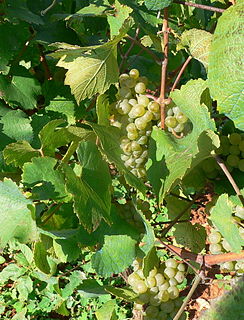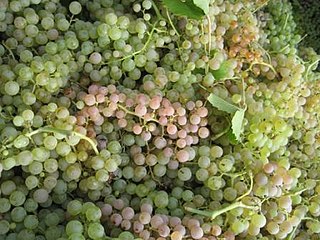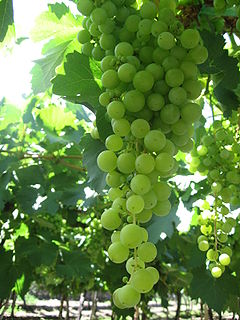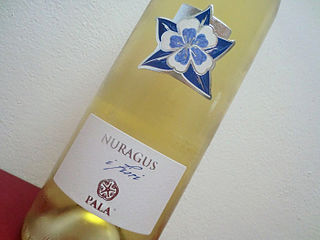
Malvasia is a group of wine grape varieties grown historically in the Mediterranean region, Balearic Islands, Canary Islands and the island of Madeira, but now grown in many of the winemaking regions of the world. In the past, the names Malvasia, Malvazia, and Malmsey have been used interchangeably for Malvasia-based wines; however, in modern oenology, "Malmsey" is now used almost exclusively for a sweet variety of Madeira wine made from the Malvasia grape. Grape varieties in this family include Malvasia bianca, Malvasia di Schierano, Malvasia negra, Malvasia nera, Malvasia nera di Brindisi, Malvasia di Candia aromatica, Malvasia odorosissima, and a number of other varieties.

Garganega is a variety of white Italian wine grape widely grown in the Veneto region of North East Italy, particularly in the provinces of Verona and Vicenza. It is Italy's 6th most widely planted white grape. It forms the basis of Venetian white wine Soave and is also a major portion of the blend used to make Gambellara.
Grignolino is a red Italian wine grape variety commonly grown in the Piedmont region. It makes light colored wines and rosés with very fruity aromas, strong acidity and tannins. The name Grignolino derives from the word grignole which means "many pips" in the local Piedmontese dialect of the Asti region. The abundance of pips, or seeds, contributes to the strong, bitter tannins associated with the wine. Modern winemakers try to avoid the excess tannins with gentle and slow pressings. Grignolino has three Denominazione di origine controllata (DOCs) that produce wine from it - Asti, Monferrato Casale, and Piemonte Grignolino.

Grüner Veltliner is a white wine grape variety grown primarily in Austria, Hungary, Slovakia, and the Czech Republic. The leaves of the grape vine are five-lobed with bunches that are long but compact, and deep green grapes that ripen in mid-late October in the Northern Hemisphere.

Verdelho is a white wine grape grown throughout Portugal, though most associated with the island of Madeira, and also gives its name to one of the four main types of Madeira wine. At the turn of the 20th century it was the most widely planted white grape in Madeira.

Verdicchio is a white Italian wine grape variety grown primarily in the Marche region of central Italy. The name Verdicchio derives from verde and refers to the slight green/yellow hue that wines made from the grape can have.

Vernaccia is a white Italian wine, made from the Vernaccia grape, produced in and around the Italian hill town of San Gimignano in Tuscany. Since the Renaissance, it has been considered one of Italy's finest white wines. It was the first Italian wine to be awarded Denominazione di Origine Controllata (DOC) status in 1966; on July 9th, 1993 it was upgraded to Denominazione di Origine Controllata e Garantita (DOCG).

Agiorgitiko is a red Greek wine grape variety that, as of 2012, was the most widely planted red grape variety in Greece, ahead of Xynomavro. The grape has traditionally been grown in the Nemea region of the Peloponnese but can be found throughout the country including Attikí (Attica) and Makedonía (Macedonia).
Arbois or Arbois Blanc is a white French wine grape variety planted primarily in the Loire regions. Despite being a minor grape, in the late 20th century it was the third most widely planted grape variety in the Loir-et-Cher département which includes the winemaking areas of Cheverny, Cour-Cheverny, Montrichard, Oisly, Saint-Romain-sur-Cher, Valençay as well as vineyards that make wines under the Touraine AOC, Cremant de Loire AOC and Vin de Pays du Loir et Cher. By 2004 acreage had steadily declined to around 750 acres. It is still a permitted grape variety in the Appellation d'origine contrôlée (AOC) regions of Cheverny AOC, Valençay AOC and Vouvray AOC.

Torrontés is a white grape variety, mostly produced and known in Argentine wine, producing fresh, aromatic wines with moderate acidity, smooth texture and mouthfeel as well as distinctive peach and apricot aromas on the nose. Three Torrontés varieties exist in Argentina: Torrontés Riojano, the most common, Torrontés Sanjuanino, and Torrontés Mendocino. It is primarily Torrontés Riojano that has received attention for the quality of its wines, and is the variety used for most Argentine wines simply labeled Torrontés.
Freisa is a red Italian wine grape variety grown in the Piedmont region of north-west Italy, primarily in Monferrato and in the Langhe, but also further north in the provinces of Turin and Biella. Freisa is a vigorous and productive vine whose round, blue-black grapes are harvested in early October. The three-lobed leaves are relatively small and the bunches are elongated in form. By the 1880s it had become one of the major Piedmontese grapes, and in that period its cultivation was stimulated by the vine’s resistance to the downy mildew caused by the Plasmopara viticola fungus. Wines made from the Freisa grape are red and usually somewhat sweet and lightly sparkling, or foaming. Still and fully sparkling versions are also produced, however, as are dry and more decidedly sweet styles. In the Canavese there is also a rosé which can be made primarily from Freisa according to Denominazione di origine controllata (DOC) regulations.
Cortese is a white Italian wine grape variety predominantly grown in the southeastern regions of Piedmont in the provinces of Alessandria and Asti. It is the primary grape of the Denominazione di origine controllata (DOC) wines of Cortese dell'Alto Monferrato and Colli Tortonesi as well as the Denominazione di Origine Controllata e Garantita (DOCG) wine of Cortese di Gavi. Significant plantings of Cortese can also be found in the Lombardy region of Oltrepò Pavese and in the DOC white blends of the Veneto wine region of Bianco di Custoza. Cortese has a long history in Italian viticulture with written documentation naming the grape among the plantings in a Piedmontese vineyard as early as 1659. The grape's moderate acidity and light flavors has made it a favorite for the restaurants in nearby Genoa as a wine pairing with the local seafood caught off the Ligurian coast.

Fiano is a white Italian wine grape variety that is grown primarily in the Campania region of southern Italy and on the island of Sicily. In Campania, this fairly strong flavored white wine grape is particularly noted around Avellino where the Denominazione di origine controllata e Garantita (DOCG) wine of Fiano di Avellino is produced. The grape has a long history in the Campanian region and is believed to have been the grape behind the ancient Roman wine Apianum. Even today, the name Apianum is permitted to appear on wine labels of the DOCG wine Fiano di Avellino.
Bombino bianco is a white Italian wine grape variety planted primarily along Italy's Adriatic coast line, most notably in Apulia. The vine is prone to high yields and often produces neutral flavor wines. The grape is known under many synonyms throughout Italy including Debit and Pagadebit, names which came from the grape's reputation for being a high yielding and reliable crop for vineyard owners to grow that would assure them that on each vintage they could pay off their debts.
Biancame is a white Italian wine grape variety that is grown in the Marche and Emilia-Romagna regions of Italy. Here it is an important component in the Denominazione di origine controllata (DOC) wines of Bianchello del Metauro and Colli di Rimini.

Viosinho is a white Portuguese wine grape variety that is grown primarily in northern Portugal where it attains high acidity levels. It is primarily found in the Trás-os-Montes and Douro DOCs. It is used primarily as a blending grape where it adds structures and flavor to both still and fortified Port wines.
Ortrugo is a white Italian wine grape variety that is grown in the Piacenza hills of the Emilia-Romagna region of north central Italy. Here the grape is often blended with Malvasia in the DOC white wines of the area. According to wine expert Oz Clarke, the grape has moderate acidity with high alcohol potential and often contributes a deep yellow color to the wine. In some regions the grape is used in slightly sparkling frizzante and fully sparkling spumante wines.

Nuragus is a white Italian wine grape variety that is grown in Sardinia. It is the principle variety between the Denominazione di origine controllata wine Nuragus di Cagliari. The grape has a long history on the island with ampelographers believing that the variety was likely introduced to the area by the Phoenicians. While the grape is still widely planted in Sardinia its numbers began to dwindle in the late 20th century, falling by 50% during the 1980s alone to a total of 8,700 hectare in 1990. Today it is mostly found in the southern part of the island between Cagliari and Oristano on the hot Campidano plain.
Rossola nera is a red Italian wine grape variety that has been growing in the Valtellina region of Lombardy since at least the 17th century. In 2004 DNA profiling determined that the grape has a parent-offspring relationship with the Piedmont wine grape Nebbiolo though which variety is the parent and which is the offspring is not yet clear. However, most ampelographers believe that Nebbiolo is likely the parent variety since written records in Piedmont have noted Nebbiolo being grown since at least the 13th century.
Bianchetta Trevigiana is a white Italian wine grape variety that is grown in the Trentino-Alto Adige/Südtirol and Veneto wine regions of northeast Italy. Here the grape is rarely used a varietal but, instead, is a permitted blending grape adding acidity to the wines of several Denominazione di Origine Controllata (DOC) zones including the sparkling wine Prosecco and has also been used for vermouth production. The name Trevigiana is derived from the province of Treviso where the grape is believed to have originated from.











